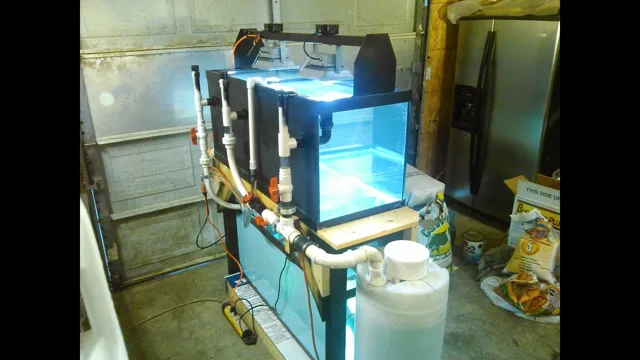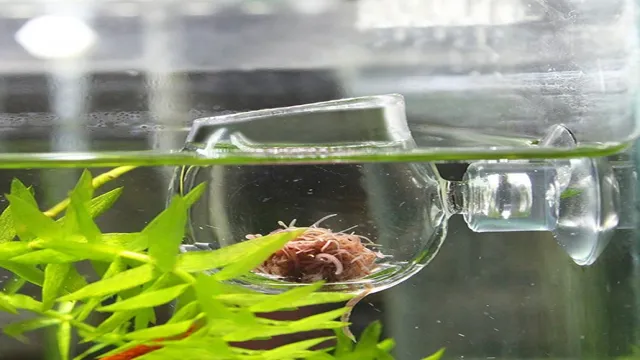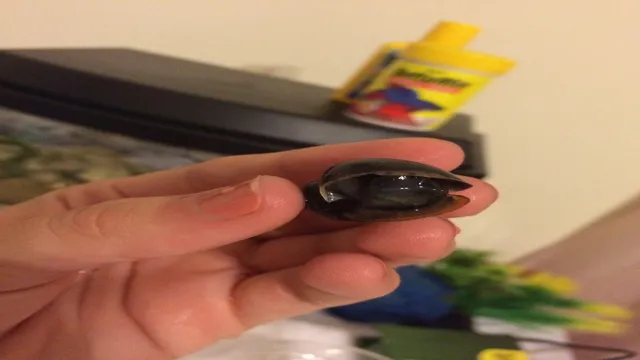Have you ever been curious about what steps you need to take to drain your aquarium? Perhaps you’re looking to switch up the decor or upgrade the filter system, but you’re unsure where to start. Whatever your reason may be, don’t worry! With a little DIY knowledge and some careful planning, draining your aquarium doesn’t have to be a daunting task. Think of it like giving your aquarium a refreshing shower — just as you would empty the water from your bathtub before scrubbing it clean, you’ll need to remove the water from your tank before making any changes.
The process may seem daunting, but fear not! This guide will walk you through all the necessary steps to ensure a safe and efficient drainage. Whether you’re a seasoned aquarium owner or a newbie, this guide will provide you with all you need to know about draining your aquarium. We’ll cover everything from gathering the necessary tools to removing your fish safely and finally re-filling your tank with fresh water.
So grab a notebook and pen, and let’s get started!
Why Should You Drain Your Aquarium?
If you are an aquarium owner, you may be wondering why you should drain your aquarium. The truth is, there are many reasons why you might want to consider doing so. For starters, draining your aquarium enables you to conduct a thorough cleaning of your tank, including removing any debris or waste that has accumulated over time.
This is essential for maintaining a healthy and sustainable environment for your fish and aquatic plants. Additionally, draining your aquarium is a great way to refresh the water and introduce new minerals and nutrients that your aquatic pets need to thrive. If you’re interested in learning how to drain your aquarium DIY-style, there are many resources available online that can guide you through the process step-by-step.
By taking the time to learn this critical skill, you’ll be better equipped to care for your aquarium and keep your aquatic pets happy and healthy for years to come.
Reasons to Drain Your Aquarium
If you’re considering draining your aquarium, there are several important reasons why you should go ahead with it. One of the main reasons is to improve the overall health of your fish and aquatic plants. Over time, waste and debris can build up in your tank and make it a breeding ground for harmful bacteria, fungus, and parasites.
Draining your tank and thoroughly cleaning it out can help remove these contaminants and create a healthier environment for your aquatic pets. Another reason to drain your aquarium is to tackle any persistent algae or fungus growth. Algae can be very difficult to get rid of, and sometimes the only solution is to start from scratch by draining and cleaning your tank.
Additionally, if you’re planning to switch up your aquarium setup or add new fish, a complete water change can help acclimate your pets to their new environment. So, if you’re looking to give your aquarium a makeover or address some persistent issues, consider draining and starting fresh – your fish and plants will thank you for it!

Precautions Before Draining Your Aquarium
Draining your aquarium is a crucial yet tricky task that requires proper planning and technique. There could be a variety of reasons for wanting to drain your aquarium, such as cleaning the tank, preparing for a move, or changing the decor. However, before starting the process, it’s essential to know how much water you’ll need to remove and what environmental impacts it may have.
This step is critical for the well-being of your aquatic life. It’s also necessary to have an understanding of what to do with the excess water and where to dispose of it. The fish in your tank need a stable environment, and abrupt changes to water chemistry or temperature can cause undue stress or even death.
Therefore, precautions should be taken when changing the water out of your fish tank to keep your aquatic friends happy and healthy.
Step by Step Guide on How to Drain Your Aquarium
Draining your aquarium might seem like a complex process, but it’s actually quite simple if you follow a few basic steps. Here’s a step-by-step guide on how to drain your aquarium DIY-style. First, turn off all electrical equipment, including heaters, filters, and pumps. (See Also: How to Make an Aquarium Look New Again: Top Tips and Tricks)
Next, siphon out the water using a hose or a large pitcher. Make sure to siphon out as much water as possible, so your aquarium is nearly empty. Once the water is mostly gone, you can use a clean cloth or towels to wipe down the inside of the tank to remove any remaining debris.
Next, ensure that the tank is completely drained, and then you can use a bucket to remove any remaining water. Lastly, dispose of the old water appropriately and clean your tank before you refill it with fresh water. Remember, regular maintenance of your aquarium is essential for the health and wellbeing of your aquatic pets, so make sure to drain your tank regularly, at least once a month, or more often if needed.
With this simple guide, you’ll be able to drain your aquarium with ease, keeping your tank and your fish happy and healthy.
Materials Needed
When it’s time to drain your aquarium, there are a few materials you’ll need to have on hand to get the job done right. Along with a bucket or two, you’ll also need a siphon hose to remove water from the tank. Make sure it’s long enough to reach the bottom of the tank and that it’s made of non-toxic materials.
You should also have a water treatment solution ready to add to the new water you’ll be refilling the tank with. Lastly, grab a fish net or container to temporarily hold your fish while you’re draining the tank. Now that you have all the materials ready, it’s time to start draining your aquarium.
First, turn off all electrical equipment and unplug it. Begin by using your siphon hose to remove about 20-25% of the tank’s water. Be careful not to disturb the substrate or any decorations in the tank.
If you have live plants in the aquarium, consider using a gentle water flow to avoid damaging the plants’ roots. Once the water level has been reduced, use the net or container to remove your fish and any other aquatic creatures from the tank. Place them in the temporary container while you finish draining the aquarium.
Continue using the siphon hose to remove the remaining water, being cautious not to remove too much to avoid stressing the fish. After all the water has been removed, use a damp cloth or sponge to wipe down the inside of the tank. This is also a good time to give the filter a quick clean.
Once the tank is clean, it’s time to refill it with fresh water. Add your water treatment solution to the new water and slowly pour it into the tank. Finally, acclimate your fish to the new water temperature by slowly adding some of the fresh water from the tank to the temporary container holding them.
Instructions on How to Drain Your Aquarium
Draining your aquarium can seem intimidating, but with the right steps, it can be an easy process. The first thing you need to do is unplug all equipment, including heaters, filters, and air pumps. If there are any live plants in the tank, be sure to remove them and set them aside.
Next, use a siphon hose to begin the draining process. Place one end of the hose in the tank and the other end in a bucket or sink. You can also attach the hose to a gravel vacuum if you need to clean the gravel.
Make sure the bucket or sink is lower than the aquarium and gravity will do the work for you. As the water drains out, be sure to keep an eye on the water level in the tank to avoid accidentally draining all the water. Once the water is drained, remove any remaining debris or soil from the gravel. (See Also: How to Get Waterstains Off Aquarium: Easy and Effective Methods)
Now you can add in new water and return the live plants and equipment. By following these simple steps, you’ll have a clean and fresh aquarium in no time.
Tips to Make Draining Your Aquarium Easier
Draining an aquarium can be a messy and time-consuming process. However, it is an essential task that needs to be done to maintain the health and cleanliness of your fish and aquatic plants. Here’s a step-by-step guide to make the process of draining your aquarium easier.
First, ensure that you have a designated area for the water to drain. Next, turn off all electrical equipment and unplug them. Then, using a siphon hose, start draining the water into a bucket or drain.
Be sure to check the hose is securely attached to prevent leakage. Once the water level reaches about a quarter of the tank, use a net to remove your fish and place them in a separate container. After draining the water, use a gravel vacuum to clean the substrate.
Refill the tank with fresh water, add de-chlorinator, and replenish the tank with your aquatic plants, decorations, and fish. With these simple steps, you can easily maintain the cleanliness of your aquarium and ensure the longevity of your aquatic life.
Final Thoughts and Cautionary Measures
Draining an aquarium can seem like a simple task, but it’s important to have cautionary measures in place to ensure the safety of your fish and preserve the cleanliness of your aquarium. Before draining, you should be sure to turn off any equipment such as filters or heaters and unplug electrical outlets to prevent any damage or electrocution. It’s also important to have a plan for where you will be releasing the water to avoid negative environmental impacts.
When using a siphon to drain the water, be sure to use a clean and sterilized container to prevent the introduction of harmful bacteria or toxins into your aquarium. Overall, with proper planning and cautionary measures, draining your aquarium can be a smooth and safe process for both you and your fish.
Things to Remember When Draining Your Aquarium
When draining your aquarium, it is important to remember to do it slowly and carefully to ensure the safety of your aquatic pets. You should also prepare the water parameters of the new tank before transferring your fish to avoid sudden changes and stress. Additionally, make sure to clean the aquarium thoroughly and remove any debris or uneaten food to prevent the formation of harmful bacteria.
It is also advisable to test the water quality regularly to monitor any changes and take appropriate actions if necessary. Furthermore, be cautious when handling the aquarium equipment and make sure to power down and unplug all electrical devices before draining the water to avoid accidents. So, always keep these essential tips in mind to maintain a healthy and happy environment for your aquatic pets while transitioning them to a new tank.
Importance of Proper Aquarium Maintenance
Proper aquarium maintenance is essential to ensure a healthy and thriving aquatic environment for your fish and other inhabitants. Neglecting regular cleaning and water changes can lead to a buildup of harmful ammonia and other toxins, causing stress and illness in your aquatic pets. Additionally, improperly maintained equipment like filters and heaters can ultimately lead to their failure, resulting in costly replacements.
It is crucial to invest time in research and learning about the specific needs of your aquarium inhabitants to ensure proper care and maintenance. Make it a priority to establish a regular schedule for cleaning and water changes, and regularly test the water parameters to monitor any potential issues. Remember, the well-being of your aquarium inhabitants depends on you! (See Also: How to Acclimate Saltwater Fish to an Aquarium: A Comprehensive Guide for Beginners)
Conclusion
In conclusion, draining an aquarium DIY-style is a task that requires patience, attention to detail, and a willingness to get a little wet. But with the right tools and a little bit of know-how, it’s a task that can be tackled by even the most novice of aquarium enthusiasts. Remember to always have a plan in place, start slowly to avoid spilling water everywhere, and use a bucket or hose to transfer the water out of the tank.
And if all else fails, just call in the professionals. After all, there’s no harm in admitting you might need a little help from the fish experts once in a while. Happy draining!”
FAQs
How can I drain my aquarium without a siphon?
One DIY way to drain your aquarium without a siphon is to use a turkey baster to manually suction out the water and transfer it to a bucket.
Can I use a garden hose to drain my aquarium?
Yes, you can attach a garden hose to your aquarium and run it outside to drain the water. Just be sure to use a water conditioner to remove any chemicals or contaminants from the tap water before refilling the tank.
How often should I drain my aquarium and replace the water?
It is recommended to do partial water changes of about 20-30% every 1-2 weeks to maintain the water quality and keep the fish healthy.
What is the best way to drain an aquarium for cleaning?
The best way to clean your aquarium is to drain the water into a clean bucket and use a gravel vacuum to remove any debris and waste from the substrate. Be sure to wipe down the walls and decorations with a clean sponge or cloth before refilling the tank.
Can I use a pump to drain my aquarium?
Yes, you can use a small pump to empty your aquarium. Just make sure to position the pump at the lowest point in the tank so it can remove as much water as possible.
How do I prevent fish from getting sucked up during draining?
To prevent fish from getting sucked up, use a net to catch them before draining the water. Alternatively, you can add an attachment to the siphon or pump that acts as a pre-filter to catch any fish or debris.
How long does it take to drain an aquarium?
The time it takes to drain an aquarium depends on the size of the tank and the method you are using. Using a siphon may take longer than using a pump or garden hose. However, it is important to take the time to drain the tank slowly to prevent stressing the fish.







